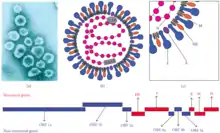Murine coronavirus
Murine coronavirus (M-CoV) is a species of coronavirus which infects mice.[3][4] It is an enveloped, positive-sense, single-stranded RNA virus which enters its host cell by binding to the CEACAM1 receptor.[5] It has, like other coronaviruses from genus Betacoronavirus, subgenus Embecovirus, an additional hemagglutinin esterase (HE) gene.[6][3]
| Murine coronavirus | |
|---|---|
 | |
| Murine coronavirus (MHV) virion electron micrograph, schematic structure, and genome | |
| Virus classification | |
| (unranked): | Virus |
| Realm: | Riboviria |
| Kingdom: | Orthornavirae |
| Phylum: | Pisuviricota |
| Class: | Pisoniviricetes |
| Order: | Nidovirales |
| Family: | Coronaviridae |
| Genus: | Betacoronavirus |
| Subgenus: | Embecovirus |
| Species: | Murine coronavirus |
| Strains | |
| |
The Murine coronavirus is a coronavirus that causes an epidemic murine illness with high mortality, especially among colonies of laboratory mice. Prior to the discovery of SARS-CoV, M-CoV (MHV, specifically) had been the best-studied coronavirus both in vivo and in vitro as well as at the molecular level. Some strains of M-CoV cause a progressive demyelinating encephalitis in mice which has been used as a murine model for multiple sclerosis. Significant research efforts have been focused on elucidating the viral pathogenesis of these animal coronaviruses, especially by virologists interested in veterinary and zoonotic diseases.
A feature of the MHV is that many strains have the hemagglutinin-esterase gene turned into a pseudogene.[7] This does not, however, apply to M-CoVs in general, as other members like PV (Puffinosis coronavirus) retain a functional version of this gene.[8]
RNA-RNA recombination
Genetic recombination can occur when at least two RNA viral genomes are present in the same infected host cell. RNA-RNA recombination between different strains of the murine coronavirus was found to occur at a very high frequency both in tissue culture[9] and in the mouse central nervous system.[10] These findings suggest that RNA-RNA recombination may play a significant role in the natural evolution and neuropathogenesis of coronaviruses.[10] The mechanism of recombination appears to involve template switching during viral genome replication, a process referred to as copy choice recombination.[10]
Strains
Sialodacryoadenitis virus (SDAV), which is a strain Rat coronavirus,[11] is highly infectious coronavirus of laboratory rats, which can be transmitted between individuals by direct contact and indirectly by aerosol. Acute infections have high morbidity and tropism for the salivary, lachrymal and harderian glands. Rabbit enteric coronavirus causes acute gastrointestinal disease and diarrhea in young European rabbits.[12] Mortality rates are high.[13]
References
- ICTV 2nd Report Fenner, F. (1976). Classification and nomenclature of viruses. Second report of the International Committee on Taxonomy of Viruses. Intervirology 7: 1-115. https://talk.ictvonline.org/ictv/proposals/ICTV%202nd%20Report.pdf
- de Groot, Raoul J.; et al. (2009). "Revision of the family Coronaviridae" (PDF). International Committee on Taxonomy of Viruses (ICTV). p. 36. Archived (PDF) from the original on 7 February 2019. Retrieved 23 January 2020.
Species Murine hepatitis virus; Puffinosis coronavirus; Rat coronavirus (these are to be united in a new species Murine coronavirus in a new genus Betacoronavirus)
- "Taxonomy browser (Murine coronavirus)". www.ncbi.nlm.nih.gov. Retrieved 2020-03-01.
- Woo, Patrick C. Y.; Huang, Yi; Lau, Susanna K. P.; Yuen, Kwok-Yung (2010-08-24). "Coronavirus Genomics and Bioinformatics Analysis". Viruses. 2 (8): 1804–1820. doi:10.3390/v2081803. ISSN 1999-4915. PMC 3185738. PMID 21994708.
Figure 2. Phylogenetic analysis of RNA-dependent RNA polymerases (Pol) of coronaviruses with complete genome sequences available. The tree was constructed by the neighbor-joining method and rooted using Breda virus polyprotein.
- Fehr, Anthony R.; Perlman, Stanley (2015). "Coronaviruses: An Overview of Their Replication and Pathogenesis". Coronaviruses. Methods in Molecular Biology (Clifton, N.J.). 1282. pp. 1–23. doi:10.1007/978-1-4939-2438-7_1. ISBN 978-1-4939-2437-0. ISSN 1064-3745. PMC 4369385. PMID 25720466.
See Table 1.
- Woo, Patrick C. Y.; Huang, Yi; Lau, Susanna K. P.; Yuen, Kwok-Yung (2010-08-24). "Coronavirus Genomics and Bioinformatics Analysis". Viruses. 2 (8): 1804–1820. doi:10.3390/v2081803. ISSN 1999-4915. PMC 3185738. PMID 21994708.
In all members of Betacoronavirus subgroup A, a haemagglutinin esterase (HE) gene, which encodes a glycoprotein with neuraminate O-acetyl-esterase activity and the active site FGDS, is present downstream to ORF1ab and upstream to S gene (Figure 1).
- Yokomori, K; Banner, LR; Lai, MM (August 1991). "Heterogeneity of gene expression of the hemagglutinin-esterase (HE) protein of murine coronaviruses". Virology. 183 (2): 647–57. doi:10.1016/0042-6822(91)90994-m. PMC 7130567. PMID 1649505.
- Klausegger, A; Strobl, B; Regl, G; Kaser, A; Luytjes, W; Vlasak, R (May 1999). "Identification of a coronavirus hemagglutinin-esterase with a substrate specificity different from those of influenza C virus and bovine coronavirus". Journal of Virology. 73 (5): 3737–43. doi:10.1128/JVI.73.5.3737-3743.1999. PMC 104150. PMID 10196267.
- Makino S, Keck JG, Stohlman SA, Lai MM. High-frequency RNA recombination of murine coronaviruses. J Virol. 1986 Mar;57(3):729-37. PMID: 3005623
- Keck JG, Matsushima GK, Makino S, Fleming JO, Vannier DM, Stohlman SA, Lai MM. In vivo RNA-RNA recombination of coronavirus in mouse brain. J Virol. 1988 May;62(5):1810-3. PMID: 2833625
- "Taxonomy browser (Embecovirus)". www.ncbi.nlm.nih.gov. Retrieved 2020-06-08.
- "Chapter 24 - Coronaviridae". Fenner's Veterinary Virology (Fifth ed.). Academic Press. 2017. pp. 435–461. doi:10.1016/B978-0-12-800946-8.00024-6. ISBN 978-0-12-800946-8.
- "Enteric Coronavirus". Diseases of Research Animals. Archived from the original on 1 July 2019. Retrieved 24 January 2020.
Further reading
- "Mouse Hepatitis Virus (MHV)" (PDF). Division of Animal Resources, University of Illinois, Urbana.
- Baker, David G. (1998). "Natural Pathogens of Laboratory Mice, Rats, and Rabbits and Their Effects on Research". Clinical Microbiology Reviews. 11 (2): 231–66. doi:10.1128/CMR.11.2.231. PMC 106832. PMID 9564563.
- Barthold, Stephen W.; Smith, Abigail L. (2006). "Mouse hepatitis virus". In Fox, James; Barthold; Davisson, Muriel; Newcomer, Christian; Quimby, Fred; Smith, Abigail (eds.). The mouse in biomedical research: Volume 2 Diseases (2nd ed.). Burlington: Elsevier. pp. 141–178. ISBN 9780080467719.
- Walls, Alexandra C.; Tortorici, M. Alejandra; Snijder, Joost; Xiong, Xiaoli; Bosch, Berend-Jan; Rey, Felix A.; Veesler, David (2017). "Tectonic conformational changes of a coronavirus spike glycoprotein promote membrane fusion". Proceedings of the National Academy of Sciences. 114 (42): 11157–11162. doi:10.1073/pnas.1708727114. PMC 5651768. PMID 29073020.